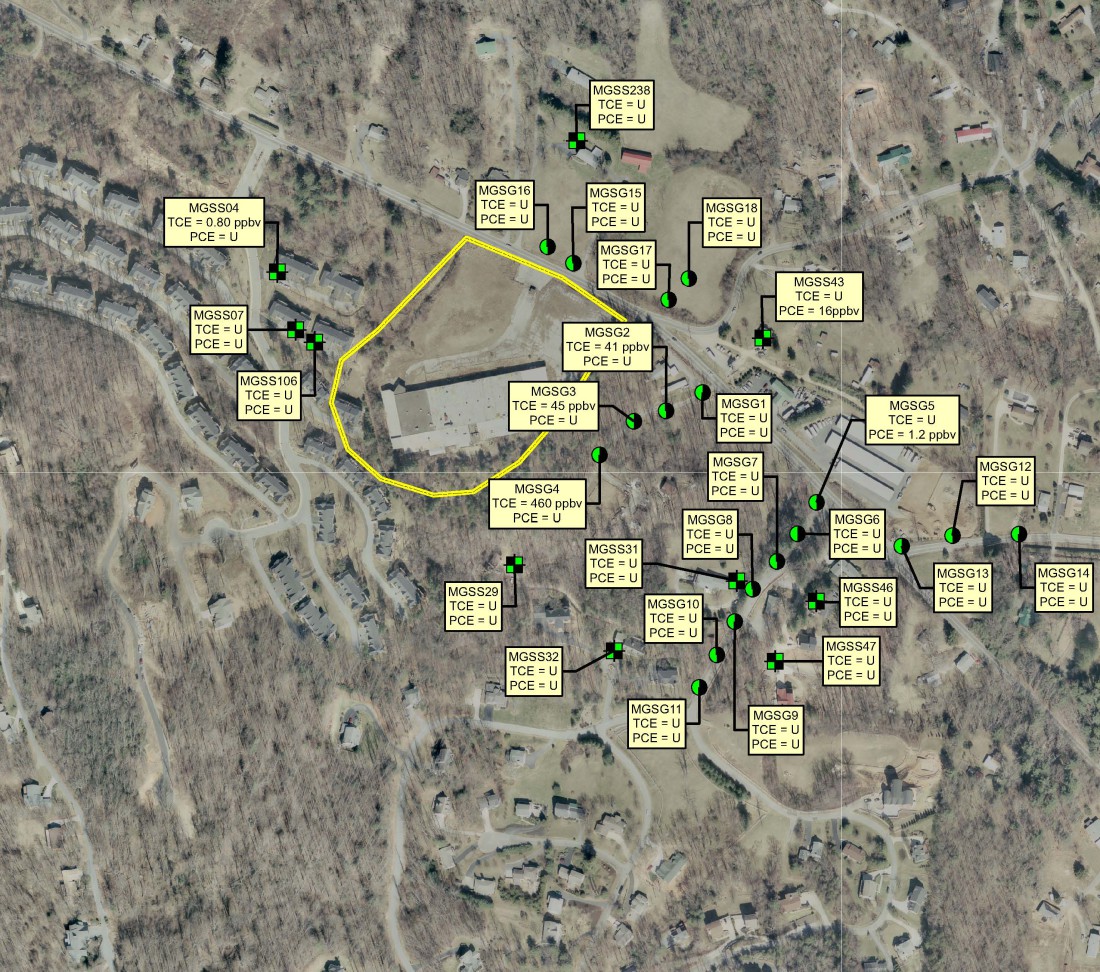When will cleanup begin at the contaminated CTS site on Mills Gap Road? 2016, says Craig Zeller, the U.S. Environmental Protection Agency’s project manager for the Superfund site.
In March, he met with Southside Village residents, whose town-home development was built on the upper part of the original 57-acre CTS property. Zeller says he explained what’s next on the remediation (or cleanup) agenda, and he reviewed two EPA letters that detailed the level of risk for Southside residents (see “EPA Clarifies Southside Village Status“). For several decades, CTS operated an electroplating plant at Mills Gap. Extremely high concentrations of trichloroethylene and other toxins used at the plant have been found in nearby springs and groundwater and on the 9-acre property that was added to the federal Superfund list in 2012.
In maps and a detailed narrative shared with Southside residents, it appears that most of the contaminants the agency tested for are labeled “U” (for “undetectable”) in the town-home development, while very high concentrations have been documented at the old slab that marks where the plant was . Zeller clarified for Xpress that finding no “unacceptable” risk in Southside doesn’t mean there’s no risk — just that the documented contaminants were at such low levels that they weren’t considered “actionable” or a cause for concern.
About 330 parts per billion of TCE were found in a stream that borders a row of homes in Southside and cuts between them and the road. Zeller points out that the stream isn’t a drinking-water source. But nearly 20,000 ppb were found in a stream on the opposite, southeast, side of the CTS site, where the Rice family built a home and, for many years, unknowingly used contaminated well water. “We’re planning to do more monitoring on the northwest side [of the Superfund site] sooner rather than later,” he says. Monitoring wells could be set up there before the end of April, he says.
Zeller also explains that, due to the site’s topography, a concentrated body of oily liquid that appears to be under and near the slab is moving to the east, toward the Rice property. This dense, nonaqueous phase liquid, or DNAPL, has become the focus of cleanup plans, and CTS must submit its action plan to the federal agency by July, choosing among four possible approaches.
One option, says Zeller, is product recovery: pumping out the oily, contaminated water and treating it. Another involves injecting an oxidation solution containing a chemical such as potassium permanganate, which is purple (“We call it ‘grape juice,'” he explains). “When you oxidize solvents, they break down into harmless products.” A third option is surfactant flushing: pumping a solution into the groundwater that will separate the TCE and other contaminants, much the way dishwashing liquids get the grease out.
A fourth option — the most aggressive and perhaps the most technically challenging, says Zeller — is electrical resistance heating: placing probes deep into the ground and running an electric current through them to heat them up. “That destroys the TCE,” he says.
Yet another possibility would be some combination of those methods, Zeller adds.
The EPA, he notes, is “required to look at a range of alternatives, from the least to the most aggressive.” In what he calls a sort of dance between the agency and the company, CTS will indicate which method it prefers; the EPA will evaluate that and push back; the public will have a chance to comment, perhaps as early as this fall; and sometime next year, a cleanup will begin.
But what about digging up the slab and everything underneath it? That option has often come up in community discussions about the CTS contamination, but Zeller says, “Generally, we avoid digging into the water table,” because disturbing the groundwater could cause further problems.
Zeller also notes that if Southside or other area residents want their homes tested, they can contact him.
Southside resident and board member Therese Figura says, “We need to be focused on cleanup.” She praises the passion and persistence of community activists such as Tate MacQueen, Barry Durand, Lee Ann Smith, Dave Ogren and many others who have helped push the EPA, CTS, state officials and local governments to take action.
Noting that she grew up during the civil rights era, Figura says it’s clear to her that the Rices and other families “have been treated unjustly. We need to stand up for them.”
To view the letters and maps, click here: 150309_Final_SSV_HOA_Letter (2)
MORE INFO
Contact Craig Zeller at zeller.craig@epa.gov or 404-562-8827.
Mountain Xpress first reported on the problem in the 2007 report “Fail Safe?” For additional stories and updates about the CTS site, visit mountainx.com/tag/cts and mountainx.com/tag/ctsofasheville.




Before you comment
The comments section is here to provide a platform for civil dialogue on the issues we face together as a local community. Xpress is committed to offering this platform for all voices, but when the tone of the discussion gets nasty or strays off topic, we believe many people choose not to participate. Xpress editors are determined to moderate comments to ensure a constructive interchange is maintained. All comments judged not to be in keeping with the spirit of civil discourse will be removed and repeat violators will be banned. See here for our terms of service. Thank you for being part of this effort to promote respectful discussion.